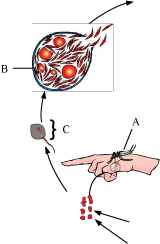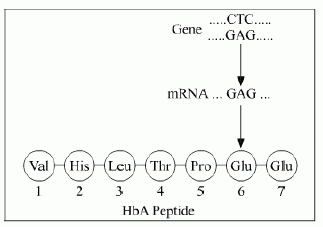Board Paper of Class 12-Science 2012 Biology Delhi(SET 1) - Solutions
(i) All questions are compulsory.
(ii) This question paper consists of four Sections A, B, C and D. Section A contains 8 questions of one mark each, Section B is of 10 questions of two marks each, Section C is of 9 questions of three marks each and Section D is of 3 questions of five marks each.
(iii) There is no overall choice. However, an internal choice has been provided in one question of 2 marks, one question of 3 marks and two questions of 5 marks weightage. A student has to attempt only one of the alternatives in such questions.
(iv) Wherever necessary, the diagrams drawn should be neat and properly labelled.
- Question 1
Mention the unique flowering phenomenon exhibited by Strobilanthus kunthiana (neelakuranaji).
VIEW SOLUTION
- Question 2
How does smoking tobacco in human lead to oxygen deficiency in their body?
VIEW SOLUTION
- Question 3
A garden pea plant (A) produced inflated yellow pod, and another plant (B) of the same species produced constricted green pods. Identify the dominant traits.
VIEW SOLUTION
- Question 4
Why is Eichhornia crassipes nicknamed as “Terror of Bengal”? (1)
VIEW SOLUTION
- Question 5
Write the location and function of the sertoli cells in humans.
VIEW SOLUTION
- Question 6
Name the following:
(a) The semi-dwarf variety of wheat is high-yielding and disease-resistant.
(b) Any one inter-specific hybrid mammal.
VIEW SOLUTION
- Question 7
Write the similarity between the wing of a butterfly and the wing of a bat. What do you infer from the above with reference to evolution?
VIEW SOLUTION
- Question 8
Write what do phytophagous insects feed on.
VIEW SOLUTION
-
Board Paper of Class 12-Science 2019 Biology Delhi(Set 2) - Solutions
-
Board Paper of Class 12-Science 2023 Biology Delhi(Set 1) - Solutions
-
Board Paper of Class 12-Science 2023 Biology Delhi(Set 2) - Solutions
-
Board Paper of Class 12-Science 2023 Biology Delhi(Set 3) - Solutions
-
Board Paper of Class 12 Science Term-II 2022 Biology Delhi(Set 1) - Solutions
-
Board Paper of Class 12 Science Term-II 2022 Biology Delhi(Set 2) - Solutions
-
Board Paper of Class 12 Science Term-II 2022 Biology Delhi(Set 3) - Solutions
-
Board Paper of Class 12 Science Term-I 2021 Biology Delhi(Set 4) (Series: SSK/3) - Solutions
-
Board Paper of Class 12-Science 2020 Biology Delhi(Set 1) - Solutions
-
Board Paper of Class 12-Science 2020 Biology Delhi(Set 2) - Solutions
-
Board Paper of Class 12-Science 2020 Biology Delhi(Set 3) - Solutions
-
Board Paper of Class 12-Science 2018 Biology Delhi(SET 1) - Solutions
-
Board Paper of Class 12-Science 2018 Biology Delhi(SET 2) - Solutions
-
Board Paper of Class 12-Science 2018 Biology Delhi(SET 3) - Solutions
-
Board Paper of Class 12-Science 2017 Biology Delhi(SET 1) - Solutions
-
Board Paper of Class 12-Science 2017 Biology Delhi(SET 2) - Solutions
-
Board Paper of Class 12-Science 2017 Biology Delhi(SET 3) - Solutions
-
Board Paper of Class 12-Science 2016 Biology Delhi(SET 1) - Solutions
-
Board Paper of Class 12-Science 2016 Biology Delhi(SET 2) - Solutions
-
Board Paper of Class 12-Science 2016 Biology Delhi(SET 3) - Solutions
-
Board Paper of Class 12-Science 2016 Biology All India(SET 1) - Solutions
-
Board Paper of Class 12-Science 2015 Biology Delhi(SET 1) - Solutions
-
Board Paper of Class 12-Science 2015 Biology Delhi(SET 2) - Solutions
-
Board Paper of Class 12-Science 2015 Biology Delhi(SET 3) - Solutions
-
Board Paper of Class 12-Science 2015 Biology All India(SET 1) - Solutions
-
Board Paper of Class 12-Science 2015 Biology All India(SET 2) - Solutions
-
Board Paper of Class 12-Science 2015 Biology Abroad(SET 3) - Solutions
-
Board Paper of Class 12-Science 2014 Biology Delhi(SET 1) - Solutions
-
Board Paper of Class 12-Science 2014 Biology Delhi(SET 2) - Solutions
-
Board Paper of Class 12-Science 2014 Biology Delhi(SET 3) - Solutions
-
Board Paper of Class 12-Science 2016 Biology Abroad(SET 2) - Solutions
-
Board Paper of Class 12-Science 2013 Biology Delhi(SET 1) - Solutions
-
Board Paper of Class 12-Science 2013 Biology Delhi(SET 2) - Solutions
-
Board Paper of Class 12-Science 2013 Biology Delhi(SET 3) - Solutions
-
Board Paper of Class 12-Science 2012 Biology Delhi(SET 2) - Solutions
-
Board Paper of Class 12-Science 2012 Biology Delhi(SET 3) - Solutions
-
Board Paper of Class 12-Science 2012 Biology All India(SET 2) - Solutions
-
Board Paper of Class 12-Science 2011 Biology Delhi(SET 1) - Solutions
-
Board Paper of Class 12-Science 2011 Biology Delhi(SET 3) - Solutions
-
Board Paper of Class 12-Science 2010 Biology Delhi(SET 3) - Solutions
-
Board Paper of Class 12-Science 2009 Biology Delhi(SET 1) - Solutions
-
Board Paper of Class 12-Science 2008 Biology Delhi(SET 1) - Solutions
-
Board Paper of Class 12-Science 2008 Biology All India(SET 1) - Solutions
-
Board Paper of Class 12-Science 2007 Biology Delhi(SET 1) - Solutions
-
Board Paper of Class 12-Science 2006 Biology Delhi(SET 1) - Solutions
-
Board Paper of Class 12-Science 2006 Biology All India(SET 1) - Solutions
-
Board Paper of Class 12-Science 2005 Biology Delhi(SET 1) - Solutions
-
Board Paper of Class 12-Science 2005 Biology All India(SET 1) - Solutions
-
Board Paper of Class 12-Science 2004 Biology Delhi(SET 1) - Solutions
-
Board Paper of Class 12-Science 2004 Biology All India(SET 1) - Solutions



